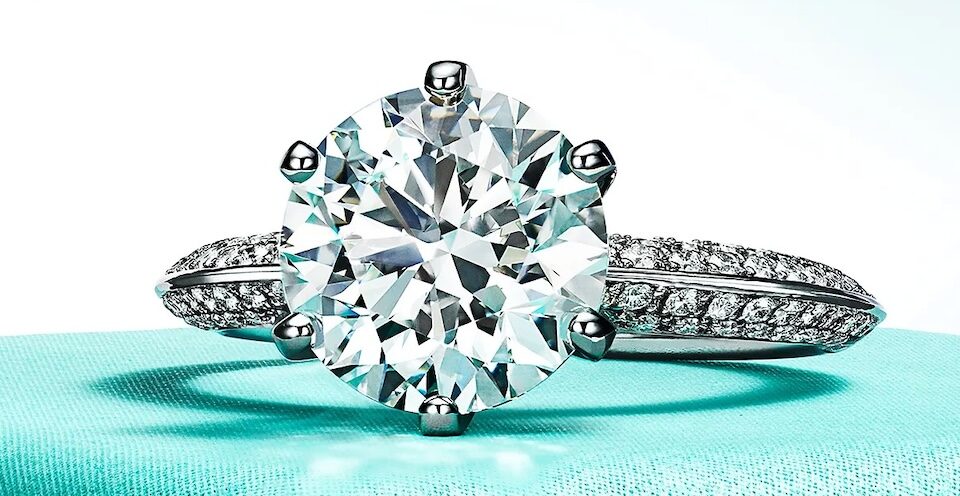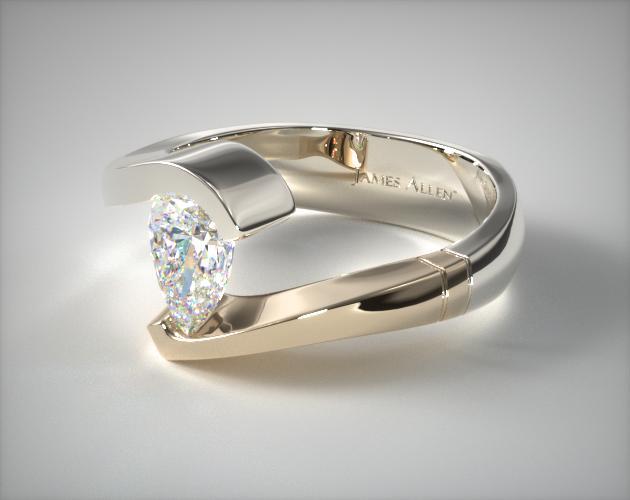
What You Need to Know About Tension Settings
November 21, 2017
Which Company Has the Best Diamond Trade-Up or Upgrade Guarantee?
December 7, 2017Timeless Pieces – Classic Style Engagement Rings
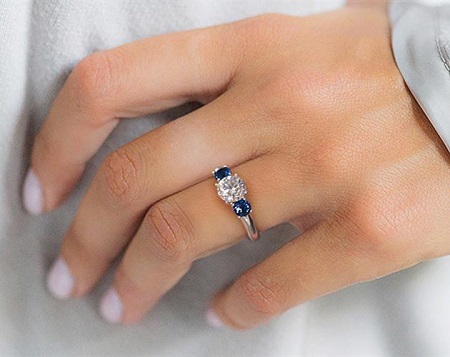
This page contains references to diamonds or engagement rings from different companies. Sometimes I do receive a commission when you click on links and buy the products.
From the moment romance blossoms with the thoughts of marriage, your mind will turn to engagement rings. Whilst there will always be a market for new and contemporary designs, we typically see classic style engagement rings being favored, and with good reason. These timeless pieces, which will, one hopes, remain worn through the course of multiple fashion changes, stand the test of time. They look as elegant, enticing, and indeed fashionable on the day of the Golden Wedding Anniversary as they did at the point of engagement.
The four top classic designs are: solitaire, halo, three-stone, and micropavé. You often see overlap between the designs (for example, you can have a micropavé combined with a halo), but each has its own distinct characteristics.
1. Solitaire
A solitaire engagement ring is simply one with a single diamond. Perhaps the most classic, and indeed the favored ring in movie, TV and cartoon engagements, and the solitaire is as classic as it gets. They are our symbol of life’s most important and memorable occasions. It is chosen precisely because it imbues timeless elegance.
This Verragio Classic Solitaire Engagement Ring is an excellent example of a timeless solitaire. It has the traditional solitaire statement diamond, but is also individual. It is the single center stone that marks it as a solitaire, yet it’s still possible to see many different intricate or simple designs in the setting.
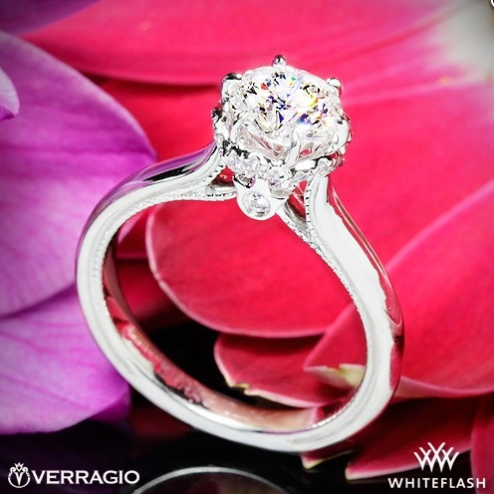
The Solitaire, whilst intensely classic, does allow room for modern creativity and flair. For example, this Bypass Engagement Ring, shows the timeless solitaire with a modern twist.
Solitaire Cut:
Of course, this ring is entirely reliant on the centerpiece diamond. As the diamond is the solo focus it’s important to choose wisely. When it comes to a solitaire you will find you can choose between multiple different cuts. Often individuals choose a round brilliant cut, but you aren’t limited by this.
The round brilliant is multi-faceted and as such provides maximum light return through the top surface of the diamond. This makes it ideal for a solitaire. However, you could choose other cuts such as emerald, cushion, princess, or pear.
Solitaire Setting:
Traditionally, solitaire engagement rings will have a prong setting, but we also see cathedral, bezel, and even tension settings as well. Prongs are generally favored as they are minimalist whilst also tightly securing the stone. The prongs raise the diamond away from the band so that it stands proud and offers maximum sparkle.
2. Halo
The halo ring is in many ways the next step from the solitaire. It’s definitely become a timeless classic since its introduction in the Art Deco famed 1920s. This time in addition to the single diamond of the solitaire, there will also be a ‘halo’ around it of smaller or tiny diamonds or colored gemstones. The center stone will have a high-carat value, and the smaller diamonds surrounding it accentuate the look of this: they make it stand out even more.
Tacori are a contemporary designer who craft modern pieces with a timeless feel. You can see this in the Tacori Full Bloom Solitaire Engagement Ring. The halo accentuates the center diamond, creating a classic style, but you also have the Tacori intricate details along the crescent profile. It’s an incredibly elegant and sophisticated piece.
There’s no reason to stop at one halo either. This Duet Halo Diamond Engagement Ring demonstrates how you can make the center diamond appear larger by creating an optical illusion.
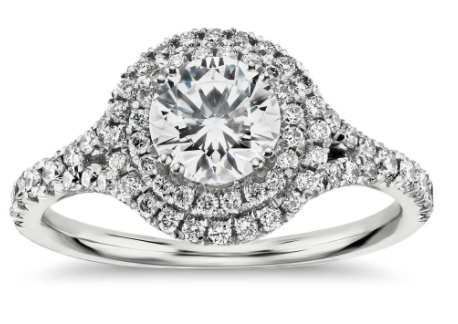
Halo rings will likely make you think of celebrities and famous faces. They are certainly popular at the moment, but will remain so. Halo rings are the ‘big’ rings we tend to associate with big names and certainly make a statement as well as becoming a valuable heirloom.
Halo Cut:
Typically the high-carat center diamond will, like the solitaire, be a round-cut. These tend to best encompass the traditional halo feel. However, you may also see the Asscher and Princess squarer cuts, or a cushion cut, radiant in a halo.
Halo Setting:
The setting on a halo ring is all about showcasing the center diamond, and in many ways the smaller diamonds dominate the setting itself. As the diamonds take the stage, the band itself is predominantly narrow and often unadorned. It’s also not unusual now to see three halos incorporated in to one ring for an intense statement piece, which brings us on to the next of our top timeless pieces.
3. Three-Stone
As its name suggests, the three-stone classic style engagement ring has three diamonds as the focus. These rings are favored for their symbolism with the three-stones believed to represent friendship, love and fidelity, and as such are often referred to as trinity or trilogy rings.
Over the last couple of decades, the 3-stone rings have been becoming increasingly popular. The 3-stones certainly allow for an injection of personality alongside timeless elegance and this is perhaps why.
Classically, a 3-stone ring will still have a larger center diamond with two slightly smaller side stones. The three stones could all be classic diamonds, or you could offset a center diamond with fancy colored diamonds, sapphire, emerald, or ruby. You have multiple choices. This Three Stone Round Blue Sapphire Engagement Ring shows how to accentuate the center diamond as well as add in color to a timeless piece.

I am particularly drawn to this Ritani Three Stone Engagement Ring because it has the timeless elegance of the three-stones, yet uses the individual and fashionable pear-cut diamonds. Its tapered band makes this a simply beautiful ring.
Three-Stone Cut:
As the ring above displays, the world is your oyster when it comes to choosing the cut of the diamonds with a three-stone. Whilst once again we traditionally see round cut diamonds, you’ll also come across a myriad of designs using the full range of different cuts.
Three-Stone Setting:
As with the cut, we see a vast spectrum of designs which fit the three-stone design brief. Some will focus on the elegance of the diamonds alone, whereas others will utilize fancy settings and intricate design.
4. Micropavé
The term ‘pavé’ is taken from the French meaning ‘paving’. Think of a street with the sidewalk perfectly paved. Pavé means to pave part of the setting, often with diamonds. Micropavé is simply doing so with intricate tiny diamonds. They will pave the shank, or part or all of the way around the ring. We also see micropavé in a halo setting.
A good example of this classic style is evident in the Simon G Delicate Diamond Engagement Ring for a Princess cut. The brilliant melee surrounding the band gives a perfect complementary backdrop to the center stone.
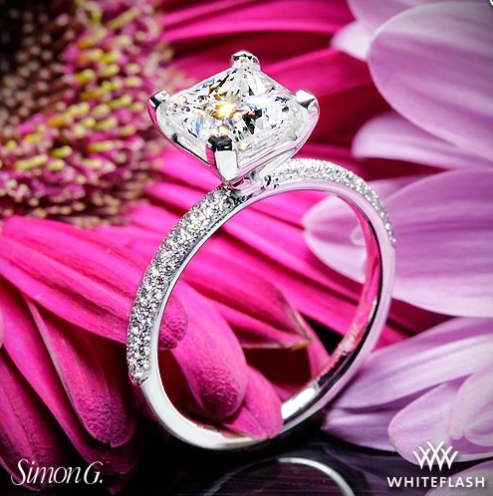
Micropavé isn’t limited to a single band either, as demonstrated in this Twin Pavé Cross Over Diamond Engagement Ring.
What is important in a micropavé design is regularity. It’s this regularity which lends itself to the timeless classic. It’s simple but inordinately effective. The result is what looks like a complete covering of diamonds. You don’t typically focus on the individual tiny diamonds themselves, but as a whole they are mesmerizing and beautiful, and ideal for showcasing the center diamond.
Micropavé Cut:
The center stone can of course be chosen according to your own preferences. You aren’t limited by cut. The micropavé diamonds themselves will be full cut diamonds just on a tiny scale. The result is a dance of light.
Micropavé Setting:
Micropavé are unarguably becoming classics, and increasingly popular, largely because traditionally they required labor-intensive, hand-crafted working. Now, modern computer-aided design (CAD) means that they are easier to complete, allowing for even more complexity.
What’s evident across all four of these classic designs is that you aren’t limited in anyway by their classic nature. There are the characteristics that make them classics that will stand the test of time, but there is also plenty of scope for individual choice and style.


